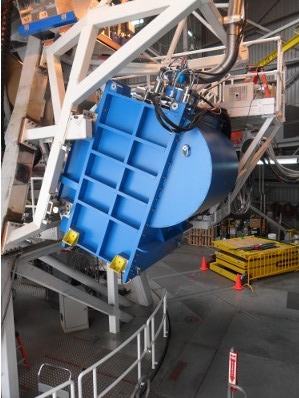 SCUBA-2 (Submillimetre Common-User Bolometer Array 2) is a 10,000 pixel bolometer camera operating simultaneously at 450 and 850 micron. The bolometers are Transition Edge Sensors (TES) fabricated on 3″ silicon wafers and read out by a Superconducting Quantum Interference Devices (SQUID) multiplexer. Each wafer has an array of 32×40 TES bolometers with the associated SQUID readout. In operation the TES balances on the normal to superconducting transition edge and are extremely sensitive to any heat input. They are made from a bilayer of Molybdenum and Copper tailored to have a transition temperature of 140 mK (850 micron) and 180 mK (450 micron).
SCUBA-2 (Submillimetre Common-User Bolometer Array 2) is a 10,000 pixel bolometer camera operating simultaneously at 450 and 850 micron. The bolometers are Transition Edge Sensors (TES) fabricated on 3″ silicon wafers and read out by a Superconducting Quantum Interference Devices (SQUID) multiplexer. Each wafer has an array of 32×40 TES bolometers with the associated SQUID readout. In operation the TES balances on the normal to superconducting transition edge and are extremely sensitive to any heat input. They are made from a bilayer of Molybdenum and Copper tailored to have a transition temperature of 140 mK (850 micron) and 180 mK (450 micron).
The camera has in total eight TES arrays, four at each wavelength band. With each array having 32×40 = 1280 bolometers there are in total 5120 bolometers per wavelength. The arrays are “naked” i.e. couple directly to the incoming radiation without any horn or cavity. This requires carefully designed optics. The instrument has a field of view is 45 arcmin2 almost completely filling the field of view of the telescope.
The instrument is cooled by three pulse tube coolers and a dilution fridge. The dilution fridge has a base temperature of about 50 mK. The focal plane that is the heat bath for the bolometers are temperature controlled at 75 mK. The instrument can operate up to a year or more without needing to be warmed up.
The main beam size of SCUBA-2 is 7.9 arcsec at 450 micron and 13.0 arcsec at 850 micron. The effective beam, however, can be described by a two-component Gaussian model which takes into
account both the main beam as well as the extended emission in a secondary error component. The effective beam FWHM is 9.8 arcsec at 450 micron and 14.6 arcsec at 850 micron. For more information, see SCUBA-2: on-sky calibration using submillimetre standard sources (Dempsey et al. 2013).
References for the design, performance and operation of SCUBA-2 are:
- Instrumentation:
- Data Reduction:
- Calibration:


